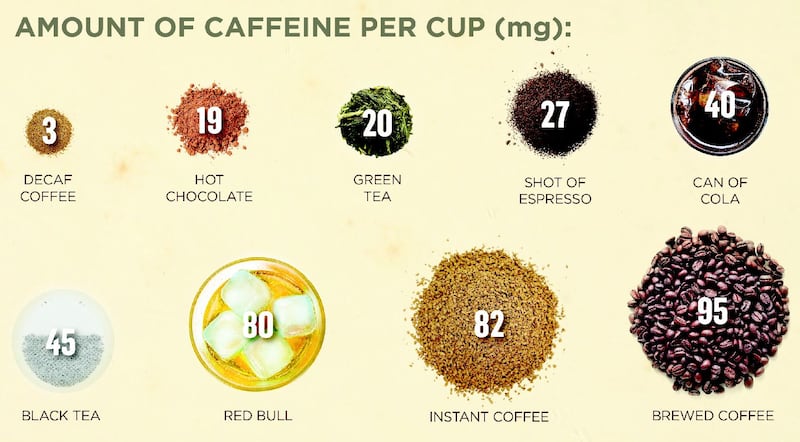Have you ever felt you needed to see a psychiatrist about your coffee-drinking habits? Thought not. But "caffeine-related disorders" are now included in the Diagnostic and Statistical Manual of Mental Disorders (DSM).
This frequently updated manual, endorsed by the American Psychiatric Association, is regularly consulted by doctors, psychologists, nurses and social workers. It all makes sense when you consider that caffeine is the most popular psychoactive drug on the planet.
“Caffeine is a drug used by almost everybody on a daily basis,” says Dr Charles O’Brien, who chairs the substance-related disorder group for the DSM. “If you drink a lot of coffee there will be a rebound or withdrawal effect.”

The listed symptoms for a caffeine-related disorder include restlessness, nervousness, excitement, gastrointestinal upset, involuntary muscle twitching, rambling speech, rapid and irregular heartbeat and sleeplessness. If that threatens to put you off coffee, be careful because “caffeine withdrawal” is also now listed as a disorder in the DSM manual.
Symptoms here include intense and prolonged headaches and psychomotor agitation, such as bouncing one leg rapidly.
If listing caffeine-related disorders as a form of “mental illness” sounds a little ridiculous – and remember homosexuality as a “disorder” was removed from the DSM manual only in 1973 – you should know that your health insurance company will probably laugh in your face if you try to claim for caffeine-related disorder treatment. As will your boss – only longer and harder – if you try to pull a “I can’t come in today, I had a mad one last night in Starbucks”.
The Jitterati
But the serious point here is that we are now drinking more coffee than ever. There are people among us – the Jitteratti as they are now known – who will pay more for their coffee than their beer. They know about bean types, freshness of roasts and makes of grinders. They speak of their Nicaraguan/ Columbian/Brazilian mixes in terms of being “light” or “fruity”. It used to be said of Irish cities and towns that there was a pub on every street; now there is a coffee shop (and sometimes two or three) on every street.
Coupled with the big sales increase of caffeine-loaded energy drinks, there is now enough concern about rising coffee consumption patterns to put it under the same health scrutiny that has been applied to sugar over the past few years. The Food and Drug Administration (FDA) in the US has launched a wide and extensive study into the effects of caffeinated products, particularly on teenagers.
In an immediate response to the FDA going public with its concerns about caffeine intake, Wrigleys decided to cancel production of its new Alert Energy chewing gum. The gum, which contained about half a cup of coffee’s worth of caffeine in each stick, promised “the right energy, right now”. Anyone consuming a pack of Alert Energy gum over the course of a day would have put themselves over the recommended daily caffeine limit which, roughly translated, is about four cups of coffee.
As a socially sanctioned and globally popular substance, if not a necessity, caffeine needs to be viewed carefully as a potent drug. The right levels – one or two cups a day can produce faster and clearer thoughts.
And there’s a good reason why so many common over the counter headache medications contain caffeine: it does help with pain relief. Even if, ironically, too much caffeine will give you a headache. Ongoing medical studies are gathering evidence that show caffeine can be a factor in preventing Type 2 diabetes and can also be a factor in a decreased risk of cognitive impairment conditions such as Alzheimer’s.
A productivity tool
But as with all drugs you walk a fine line. Too much caffeine – whether from coffee or energy drinks – can make you nervous, restless, feel “spaced out”, give you an apparent accelerated heart rate, cause insomnia (many people can’t touch caffeine after 6pm) and give you an unpleasant “crash” feeling as your body tries to cope with its powerful actions.
Coffee is a different type of drug. Whereas alcohol would be used as a relaxant by many, coffee is used as a productivity tool. Therein lies its hidden danger.
Brian Kenny, one of Ireland’s coffee experts, who runs the always busy Coffee Kiosk in Ballsbridge, says: “In the right dose – a couple of cups a day – all the evidence suggests coffee can actually be good for you. In fact, the big new health news now is the use of the green coffee bean extract. But if you have health concerns, stick to filter coffee not the syrupy, sugar-loaded drinks you can get in chain coffee shops.”
The main problem here, though, is not your average cup of coffee but with all the new energy drinks on the market that are aimed at a younger demographic. A can of the popular Red Bull energy drink contains the same amount of caffeine as an espresso but it would be common for people to consume three or four cans a day.
The Red Bull company stresses that its product is a “functional” drink, not to be lashed into recreationally but rather to be taken to fulfil the need to feel alert for a certain purpose.
Just as coffee should be used.

















